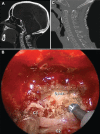Application of ultrasonic bone curette in endoscopic endonasal skull base surgery: technical note
- PMID: 24719795
- PMCID: PMC3969437
- DOI: 10.1055/s-0033-1354580
Application of ultrasonic bone curette in endoscopic endonasal skull base surgery: technical note
Abstract
Background Endoscopic endonasal surgery (EES) of the skull base often requires extensive bone work in proximity to critical neurovascular structures. Objective To demonstrate the application of an ultrasonic bone curette during EES. Methods Ten patients with skull base lesions underwent EES from September 2011 to April 2012 at the University of Pittsburgh Medical Center. Most of the bone work was done with high-speed drill and rongeurs. The ultrasonic curette was used to remove specific structures. Results All the patients were submitted to fully endoscopic endonasal procedures and had critical bony structures removed with the ultrasonic bone curette. Two patients with degenerative spine diseases underwent odontoid process removal. Five patients with clival and petroclival tumors underwent posterior clinoid removal. Two patients with anterior fossa tumors underwent crista galli removal. One patient underwent unilateral optic nerve decompression. No mechanical or heat injury resulted from the ultrasonic curette. The surrounding neurovascular structures and soft tissue were preserved in all cases. Conclusion In selected EES, the ultrasonic bone curette was successfully used to remove loose pieces of bone in narrow corridors, adjacent to neurovascular structures, and it has advantages to high-speed drills in these specific situations.
Keywords: bone removal; endoscopic endonasal; skull base; ultrasonic bone curette.
Figures





Similar articles
-
Bone removal with a new ultrasonic bone curette during endoscopic endonasal approach to the sellar-suprasellar area: technical note.Neurosurgery. 2010 Mar;66(suppl_1):ons-E118. doi: 10.1227/01.NEU.0000365929.26699.02. Neurosurgery. 2010. PMID: 20124924
-
Safety of spinal decompression using an ultrasonic bone curette compared with a high-speed drill: outcomes in 337 patients.J Neurosurg Spine. 2013 Jun;18(6):627-33. doi: 10.3171/2013.2.SPINE12879. Epub 2013 Apr 5. J Neurosurg Spine. 2013. PMID: 23560712
-
[Effects of ultrasonic bone curettes combined with high-speed drills in posterior laminectomy and decompression procedure for severe thoracic spinal stenosis].Zhonghua Yi Xue Za Zhi. 2020 Feb 25;100(7):521-526. doi: 10.3760/cma.j.issn.0376-2491.2019.07.009. Zhonghua Yi Xue Za Zhi. 2020. PMID: 32164104 Chinese.
-
The Endoscopic Endonasal Approach for Removal of Petroclival Chondrosarcomas.Neurosurg Clin N Am. 2015 Jul;26(3):453-62. doi: 10.1016/j.nec.2015.03.008. Epub 2015 May 28. Neurosurg Clin N Am. 2015. PMID: 26141363 Review.
-
Extended endoscopic endonasal approach to the midline skull base: the evolving role of transsphenoidal surgery.Adv Tech Stand Neurosurg. 2008;33:151-99. doi: 10.1007/978-3-211-72283-1_4. Adv Tech Stand Neurosurg. 2008. PMID: 18383814 Review.
Cited by
-
Deep Lateral Wall Partial Rim-Sparing Orbital Decompression with Ultrasonic Bone Removal for Treatment of Thyroid-Related Orbitopathy.J Ophthalmol. 2019 Dec 2;2019:9478512. doi: 10.1155/2019/9478512. eCollection 2019. J Ophthalmol. 2019. PMID: 31885895 Free PMC article.
-
Use of Ultrasonic Device in Cervical and Thoracic Laminectomy: a Retrospective Comparative Study and Technical Note.Sci Rep. 2018 Mar 5;8(1):4006. doi: 10.1038/s41598-018-22454-y. Sci Rep. 2018. PMID: 29507350 Free PMC article.
-
Dural Changes Induced by an Ultrasonic Bone Curette in an Excised Porcine Spinal Cord.Vet Sci. 2022 Oct 28;9(11):601. doi: 10.3390/vetsci9110601. Vet Sci. 2022. PMID: 36356078 Free PMC article.
-
Specialised Surgical Instruments for Endoscopic and Endoscope-Assisted Neurosurgery: A Systematic Review of Safety, Efficacy and Usability.Cancers (Basel). 2022 Jun 14;14(12):2931. doi: 10.3390/cancers14122931. Cancers (Basel). 2022. PMID: 35740595 Free PMC article. Review.
-
Novel Application of an Ultrasonic Bone Aspirator for Endoscopic Modified Medial Maxillectomy.Front Surg. 2022 Jun 1;9:870380. doi: 10.3389/fsurg.2022.870380. eCollection 2022. Front Surg. 2022. PMID: 35722534 Free PMC article.
References
-
- Maroon J C. Skull base surgery: past, present, and future trends. Neurosurg Focus. 2005;19(1):E1. - PubMed
-
- Prevedello D M, Doglietto F, Jane J A Jr, Jagannathan J, Han J, Laws E R Jr. History of endoscopic skull base surgery: its evolution and current reality. J Neurosurg. 2007;107(1):206–213. - PubMed
-
- Snyderman C H, Pant H, Carrau R L, Prevedello D, Gardner P, Kassam A B. What are the limits of endoscopic sinus surgery?: the expanded endonasal approach to the skull base. Keio J Med. 2009;58(3):152–160. - PubMed
-
- Yamasaki T, Moritake K, Nagai H, Uemura T, Shingu T, Matsumoto Y. A new, miniature ultrasonic surgical aspirator with a handpiece designed for transsphenoidal surgery. Technical note. J Neurosurg. 2003;99(1):177–179. - PubMed
-
- Pagella F, Giourgos G, Matti E, Colombo A, Carena P. Removal of a fronto-ethmoidal osteoma using the Sonopet omni ultrasonic bone curette: first impressions. Laryngoscope. 2008;118(2):307–309. - PubMed
LinkOut - more resources
Full Text Sources
Other Literature Sources
Miscellaneous

